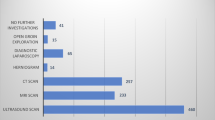Abstract
Background
NICE (National Institute of Health and Clinical Excellence) in England recommended laparoscopic repair for recurrent and bilateral groin hernias in 2004. The aims of this survey were to evaluate the current practise of bilateral and recurrent inguinal hernia surgery in Scotland and surgeons’ views on the perceived need for training in laparoscopic inguinal hernia repair (LIHR).
Methods
A postal questionnaire was sent to Scottish consultant surgeons included in the Scottish Audit of Surgical Audit database 2007, asking about their current practice of primary, recurrent and bilateral inguinal hernia surgery. A response was considered valid if the surgeon performed groin hernia surgery; further analysis was based on this group. Those who did not offer LIHR were asked to comment on the possible reasons, and also the perceived need for training in laparoscopic hernia surgery. Only valid responses were stored on Microsoft Excel (Microsoft Corporation, USA) and analysed with SPSS software version 13.0 (SPSS, Chicago, Illinois).
Results
Postal questionnaires were sent to 301 surgeons and the overall all response rate was 174/301 (57.8%). A valid response was received from 124 of 174 (71.2%) surgeons and analysed further. Open Lichtenstein’s repair seems to be the most common inguinal hernia repair. Laparoscopic surgery was not performed for 26.6 and 31.5% of recurrent and bilateral inguinal hernia, respectively. About 15% of surgeons replied that an LIHR service was not available in their base hospital. Lack of training, financial constraints, and insufficient evidence were thought to be the main reasons for low uptake of LIHR. About 80% of respondents wished to attend hands-on training in hernia surgery.
Conclusions
Current practice by Scottish surgeons showed that one in three surgeons did not offer LIHR for bilateral and recurrent inguinal hernia as recommended by NICE. There is a clear need for training in LIHR.
Similar content being viewed by others
References
National Institute for Clinical Excellence. Technology appraisal guidance no 83: Guidance on the use of laparoscopic surgery for inguinal hernia. London: NICE, 2004 uptake report
Sanjay P, Woodward A (2007) A survey of inguinal hernia repair in Wales with special emphasis on laparoscopic repair. Hernia 11:403–407. doi:10.1007/s10029-007-0241-4
Stevenson AD, Nixon SJ, Paterson-Brown S (2010) Variation of laparoscopic hernia repair in Scotland: a postcode lottery? Surgeon 8:140–143. doi:10.1016/j.surge.2009.11.001
Hair A, Duffy K, McLean J, Taylor S, Smith H, Walker A, MacIntyre IM, O’Dwyer PJ (2000) Groin hernia repair in Scotland. Br J Surg 87:1722–1726
Tse GH, de Beaux AC (2008) Laparoscopic hernia repair. Scott Med J 53:34–37
McCormack K, Wake BL, Fraser C, Vale L, Perez J, Grant A (2005) Transabdominal pre-peritoneal (TAPP) versus totally extraperitoneal (TEP) laparoscopic techniques for inguinal hernia repair: a systematic review. Hernia 9:109–114. doi:10.1007/s10029-004-0309-3
Memon MA, Cooper NJ, Memon B, Memon MI, Abrams KR (2003) Meta-analysis of randomized clinical trials comparing open and laparoscopic inguinal hernia repair. Br J Surg 90:1479–1492. doi:10.1002/bjs.4301
McCormack K, Wake B, Perez J, Fraser C, Cook J, McIntosh E, Vale L, Grant A (2005) Laparoscopic surgery for inguinal hernia repair: systematic review of effectiveness and economic evaluation. Health Technol Assess 9:1–203 iii–iv
Eklund A, Rudberg C, Smedberg S, Enander LK, Leijonmarck CE, Osterberg J, Montgomery A (2006) Short-term results of a randomized clinical trial comparing Lichtenstein open repair with totally extraperitoneal laparoscopic inguinal hernia repair. Br J Surg 93:1060–1068. doi:10.1002/bjs.5405
Eklund A, Montgomery A, Bergkvist L, Rudberg C, Swedish multicentre trial of inguinal hernia repair by laparoscopy (SMIL) study group (2010) Chronic pain 5 years after randomized comparison of laparoscopic and Lichtenstein inguinal hernia repair. Br J Surg 97:600–608. doi:10.1002/bjs.6904
Lau H, Patil NG, Yuen WK (2006) Day-case endoscopic totally extraperitoneal inguinal hernioplasty versus open Lichtenstein hernioplasty for unilateral primary inguinal hernia in males: a randomized trial. Surg Endosc 20:76–81. doi:10.1007/s00464-005-0203-9
Alkhaffaf B, Decadt B (2010) Litigation following groin hernia repair in England. Hernia 14:181–186. doi:10.1007/s10029-009-0595-x
Kald A, Anderberg B, Carlsson P, Park PO, Smedh K (1997) Surgical outcome and cost-minimisation-analyses of laparoscopic and open hernia repair: a randomised prospective trial with one year follow up. Eur J Surg 163:505–510
Butters M, Redecke J, Koninger J (2007) Long-term results of a randomized clinical trial of Shouldice, Lichtenstein and transabdominal preperitoneal hernia repairs. Br J Surg 94:562–565. doi:10.1002/bjs.5733
The MRC Laparoscopic Groin Hernia Trial Group (1999) Laparoscopic versus open repair of groin hernia: a randomised comparison. Lancet 354:185–190
Neumayer L, Giobbie-Hurder A, Jonasson O, Fitzgibbons R Jr, Dunlop D, Gibbs J, Reda D, Henderson W, Veterans Affairs Cooperative Studies Program 456 Investigators (2004) Open mesh versus laparoscopic mesh repair of inguinal hernia. N Engl J Med 350:1819–1827. doi:10.1056/NEJMoa040093
Wright D, Paterson C, Scott N, Hair A, O’Dwyer PJ (2002) Five-year follow-up of patients undergoing laparoscopic or open groin hernia repair: a randomized controlled trial. Ann Surg 235:333–337
Duff M, Mofidi R, Nixon SJ (2007) Routine laparoscopic repair of primary unilateral inguinal hernias–a viable alternative in the day surgery unit? Surgeon 5:209–212
Rosenberg J, Bay-Nielsen M (2008) Current status of laparoscopic inguinal hernia repair in Denmark. Hernia 12:583–587. doi:10.1007/s10029-008-0399-4
Wilkiemeyer M, Pappas TN, Giobbie-Hurder A, Itani KM, Jonasson O, Neumayer LA (2005) Does resident post graduate year influence the outcomes of inguinal hernia repair? Ann Surg 241:879–882 (discussion 882–884)
Author information
Authors and Affiliations
Corresponding authors
Rights and permissions
About this article
Cite this article
Shaikh, I., Olabi, B., Wong, V.M.Y. et al. NICE guidance and current practise of recurrent and bilateral groin hernia repair by Scottish surgeons. Hernia 15, 387–391 (2011). https://doi.org/10.1007/s10029-011-0797-x
Received:
Accepted:
Published:
Issue Date:
DOI: https://doi.org/10.1007/s10029-011-0797-x




